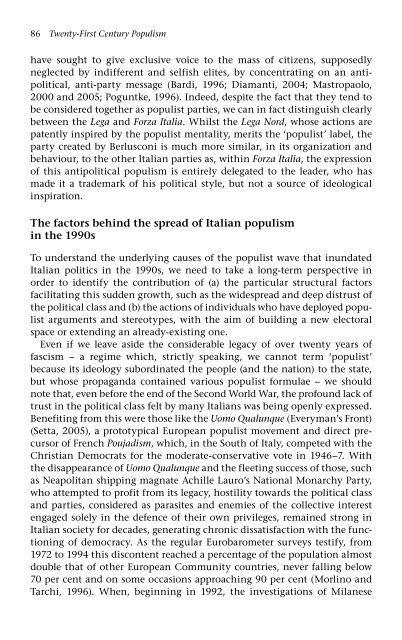Twenty-First Century Populism: The Spectre of Western European ...
Twenty-First Century Populism: The Spectre of Western European ...
Twenty-First Century Populism: The Spectre of Western European ...
Create successful ePaper yourself
Turn your PDF publications into a flip-book with our unique Google optimized e-Paper software.
86 <strong>Twenty</strong>-<strong>First</strong> <strong>Century</strong> <strong>Populism</strong><br />
have sought to give exclusive voice to the mass <strong>of</strong> citizens, supposedly<br />
neglected by indifferent and selfish elites, by concentrating on an antipolitical,<br />
anti-party message (Bardi, 1996; Diamanti, 2004; Mastropaolo,<br />
2000 and 2005; Poguntke, 1996). Indeed, despite the fact that they tend to<br />
be considered together as populist parties, we can in fact distinguish clearly<br />
between the Lega and Forza Italia. Whilst the Lega Nord, whose actions are<br />
patently inspired by the populist mentality, merits the ‘populist’ label, the<br />
party created by Berlusconi is much more similar, in its organization and<br />
behaviour, to the other Italian parties as, within Forza Italia, the expression<br />
<strong>of</strong> this antipolitical populism is entirely delegated to the leader, who has<br />
made it a trademark <strong>of</strong> his political style, but not a source <strong>of</strong> ideological<br />
inspiration.<br />
<strong>The</strong> factors behind the spread <strong>of</strong> Italian populism<br />
in the 1990s<br />
To understand the underlying causes <strong>of</strong> the populist wave that inundated<br />
Italian politics in the 1990s, we need to take a long-term perspective in<br />
order to identify the contribution <strong>of</strong> (a) the particular structural factors<br />
facilitating this sudden growth, such as the widespread and deep distrust <strong>of</strong><br />
the political class and (b) the actions <strong>of</strong> individuals who have deployed populist<br />
arguments and stereotypes, with the aim <strong>of</strong> building a new electoral<br />
space or extending an already-existing one.<br />
Even if we leave aside the considerable legacy <strong>of</strong> over twenty years <strong>of</strong><br />
fascism − a regime which, strictly speaking, we cannot term ‘populist’<br />
because its ideology subordinated the people (and the nation) to the state,<br />
but whose propaganda contained various populist formulae − we should<br />
note that, even before the end <strong>of</strong> the Second World War, the pr<strong>of</strong>ound lack <strong>of</strong><br />
trust in the political class felt by many Italians was being openly expressed.<br />
Benefiting from this were those like the Uomo Qualunque (Everyman’s Front)<br />
(Setta, 2005), a prototypical <strong>European</strong> populist movement and direct precursor<br />
<strong>of</strong> French Poujadism, which, in the South <strong>of</strong> Italy, competed with the<br />
Christian Democrats for the moderate-conservative vote in 1946−7. With<br />
the disappearance <strong>of</strong> Uomo Qualunque and the fleeting success <strong>of</strong> those, such<br />
as Neapolitan shipping magnate Achille Lauro’s National Monarchy Party,<br />
who attempted to pr<strong>of</strong>it from its legacy, hostility towards the political class<br />
and parties, considered as parasites and enemies <strong>of</strong> the collective interest<br />
engaged solely in the defence <strong>of</strong> their own privileges, remained strong in<br />
Italian society for decades, generating chronic dissatisfaction with the functioning<br />
<strong>of</strong> democracy. As the regular Eurobarometer surveys testify, from<br />
1972 to 1994 this discontent reached a percentage <strong>of</strong> the population almost<br />
double that <strong>of</strong> other <strong>European</strong> Community countries, never falling below<br />
70 per cent and on some occasions approaching 90 per cent (Morlino and<br />
Tarchi, 1996). When, beginning in 1992, the investigations <strong>of</strong> Milanese



